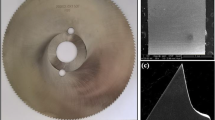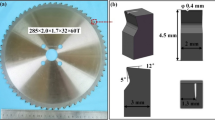Abstract
The problems of severe sawtooth wear, harsh sawing noise, and low surface quality during the processing of circular saw blades need to be solved. To improve the cutting performance of TiC-based cermet saw blades, microtextures parallel to the cutting edge were fabricated on rough and fine sawteeth by laser machining. The cutting tests were performed on a sawing platform under lubricated conditions. Models of the sawing arc length and working sawtooth cutting force variations were developed for sawing steel pipes, and the accuracy of the sawing force model was verified experimentally. The results indicate that the variations in the sawing force are proportional to the sawing arc length. The circular saw blades with microtextures that did not penetrate the sawtooth rake face exhibited the lowest cutting force, sawing noise, and highest machined surface quality. Furthermore, the worn-out distance of the rougher and finisher sawteeth was reduced by approximately 7.4% and 44.1%, respectively, compared with conventional circular saw blades. The main failure modes of sawteeth were tip wear, rake face adhesion, and oxidative wear. In addition, the mechanism by which the textures improve the cutting and wear properties of TiC-based circular saw blades was discussed. This study provided a significant concept for enhancing the cutting performance of circular saw blades and improving the machined surface quality.




















Similar content being viewed by others
References
Xavior MA, Adithan M (2009) Determining the influence of cutting fluids on tool wear and surface roughness during turning of AISI 304 austenitic stainless steel. J Mater Process Technol 209:900–909
Gupta RK, Birbilis N (2015) The influence of nanocrystalline structure and processing route on corrosion of stainless steel: a review. Corros Sci 92:1–15
Jiménez-Pichardo R, Regalado C, Castaño-Tostado E et al (2016) Evaluation of electrolyzed water as cleaning and disinfection agent on stainless steel as a model surface in the dairy industry. Food Control 60:320–328
Sousa VFC, Silva FJG, Alexandre R et al (2023) Experimental study on the wear evolution of different PVD coated tools under milling operations of LDX2101 duplex stainless steel. Adv Manuf 11:158–179
Tekıner Z, Yeşılyurt S (2004) Investigation of the cutting parameters depending on process sound during turning of AISI 304 austenitic stainless steel. Mater Des 25:507–513
Lu Y, Deng J, Sun Q et al (2021) Effect of micro textures on the cutting performance of circular saw blade. Int J Adv Manuf Technol 115:2889–2903
Malinowska-Borowska J, Socholik V, Harazin B (2012) The health condition of forest workers exposed to noise and vibration produced by chain saws. Med Pr 63:19–29
Sarwar M, Haider J (2010) Aspects of burr formation in bandsaw teeth manufactured by milling operation. Robot Comput Integr Manuf 26:596–601
Lewis DB, Bradbury SR, Sarwar M (1996) Analysis of the wear and failure mechanisms that develop in high speed steel circular saw blades when machining nickel-based alloys. Wear 197:74–81
Chang WT, Chen LC (2016) Design and experimental evaluation of a circular saw blade with self-clamped cutting inserts. Int J Adv Manuf Technol 83:365–379
Lewis DB, Bradbury SR, Sarwar M (1996) The effect of substrate surface preparation on the wear and failure modes of TiN coated high speed steel circular saw blades. Wear 197:82–88
Nishio S, Marui E (1996) Effects of slots on the lateral vibration of a circular saw blade. Int J Mach Tools Manuf 36:771–787
Sarwar M, Bradbury SR, Lewis DB (1996) Optimizing the performance of high speed steel circular saw blades machining cupro 107, Inconel 600L and Nimonic PK31 nickel based alloys. J Mater Sci 31:3613–3616
Nasir V, Kooshkbaghi M, Cool J et al (2021) Cutting tool temperature monitoring in circular sawing: measurement and multi-sensor feature fusion-based prediction. Int J Adv Manuf Technol 112:2413–2424
Svoreň J, Naščák Ľ, Koleda P et al (2021) The circular saw blade body modification by elastic material layer effecting circular saws sound pressure level when idling and cutting. Appl Acoust 179:108028. https://doi.org/10.1016/j.apacoust.2021.108028
Pohl M, Rose M (2016) Piezoelectric shunt dam** of a circular saw blade with autonomous power supply for noise and vibration reduction. J Sound Vib 361:20–31
Bradbury SR, Lewis DB, Sarwar M (1996) The effect of product quality on the integrity of advanced surface engineering treatments applied to high speed steel circular saw blades. Surf Coat Technol 85:215–220
He Y, **ao G, Zhu S et al (2023) Surface formation in laser-assisted grinding high-strength alloys. Int J Mach Tools Manuf 186:104002. https://doi.org/10.1016/j.ijmachtools.2023.104002
Guo X, Huang Q, Wang C et al (2022) Effect of magnetic field on cutting performance of micro-textured tools under Fe3O4 nanofluid lubrication condition. J Mater Process Technol 299:117382. https://doi.org/10.1016/j.jmatprotec.2021.117382
Pratap T, Patra K (2018) Fabrication of micro-textured surfaces using ball-end micromilling for wettability enhancement of Ti-6Al-4V. J Mater Process Technol 262:168–181
Zhou C, Guo X, Zhang K et al (2019) The coupling effect of micro-groove textures and nanofluids on cutting performance of uncoated cemented carbide tools in milling Ti-6Al-4V. J Mater Process Technol 271:36–45
Niketh S, Samuel GL (2017) Surface texturing for tribology enhancement and its application on drill tool for the sustainable machining of titanium alloy. J Clean Prod 167:253–270
Pang K, Wang D (2020) Study on the performances of the drilling process of nickel-based superalloy Inconel 718 with differently micro-textured drilling tools. Int J Mech Sci 180:105658. https://doi.org/10.1016/j.ijmecsci.2020.105658
Ni J, Li B, Xu J et al (2016) Investigation on broaching performance and unloading mechanism of micro-textured broach. Int J Adv Manuf Technol 86:2449–2458
Arslan A, Masjuki HH, Kalam MA et al (2016) Surface texture manufacturing techniques and tribological effect of surface texturing on cutting tool performance: a review. Crit Rev Solid State Mater Sci 41:447–481
Mishra SK, Ghosh S, Aravindan S (2018) 3D finite element investigations on textured tools with different geometrical shapes for dry machining of titanium alloys. Int J Mech Sci 141:424–449
Liu GL, Zheng JT, Huang CZ et al (2023) Coupling effect of micro-textured tools and cooling conditions on the turning performance of aluminum alloy 6061. Adv Manuf 11:663–681
Orra K, Choudhury SK (2018) Tribological aspects of various geometrically shaped micro-textures on cutting insert to improve tool life in hard turning process. J Manuf Process 31:502–513
Kawasegi N, Sugimori H, Morimoto H et al (2009) Development of cutting tools with microscale and nanoscale textures to improve frictional behavior. Precis Eng 33:248–254
Sugihara T, Nishimoto Y, Enomoto T (2017) Development of a novel cubic boron nitride cutting tool with a textured flank face for high-speed machining of Inconel 718. Precis Eng 48:75–82
Sugihara T, Kobayashi R, Enomoto T (2021) Direct observations of tribological behavior in cutting with textured cutting tools. Int J Mach Tools Manuf 168:103726. https://doi.org/10.1016/j.ijmachtools.2021.103726
Duan R, Deng J, Lei S et al (2019) Effect of derivative cutting on machining performance of micro textured tools. J Manuf Process 45:544–556
Chen RY (1992) Principle of metal cutting. China Machine Press, Bei**g
Deng JX, Wu Z, Lian YS et al (2012) Performance of carbide tools with textured rake-face filled with solid lubricants in dry cutting processes. Int J Refract Met Hard Mater 30:164–172
Sharma S, Mandal V, Ramakrishna SA et al (2019) Numerical simulation of melt pool oscillations and protuberance in pulsed laser micro melting of SS304 for surface texturing applications. J Manuf Process 39:282–294
Acknowledgements
This work was supported by the National Natural Science Foundation of China (Grant No.52275443), and the Key Research and Development Projects of Shandong Province (Grant No.2020CXGC011003).
Author information
Authors and Affiliations
Corresponding author
Rights and permissions
Springer Nature or its licensor (e.g. a society or other partner) holds exclusive rights to this article under a publishing agreement with the author(s) or other rightsholder(s); author self-archiving of the accepted manuscript version of this article is solely governed by the terms of such publishing agreement and applicable law.
About this article
Cite this article
Lu, Y., Deng, JX., Zhang, ZH. et al. Cutting performance of saw blades with microtextured rougher and finisher sawteeth. Adv. Manuf. 12, 317–334 (2024). https://doi.org/10.1007/s40436-023-00470-0
Received:
Revised:
Accepted:
Published:
Issue Date:
DOI: https://doi.org/10.1007/s40436-023-00470-0




